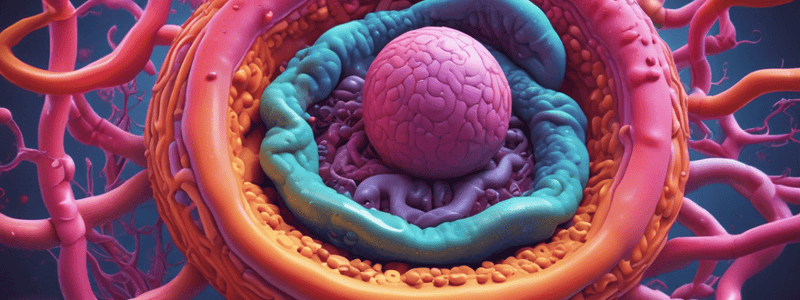Podcast
Questions and Answers
What is the main cause of inflammatory diarrhoea?
What is the main cause of inflammatory diarrhoea?
- Impaired intestinal motility
- Excessive luminal content absorption
- Infectious agents (correct)
- Reduced blood supply to the intestines
Which condition can lead to dysmotility diarrhoea?
Which condition can lead to dysmotility diarrhoea?
- Ulcerative Colitis
- Irritable Bowel Syndrome (IBS) (correct)
- Ischemic injury
- Crohn’s Disease
What happens when there is impaired intestinal motility?
What happens when there is impaired intestinal motility?
- Enhanced mixing of luminal contents
- Reduced fluid leakage into the intestinal lumen
- Abnormal transit times (correct)
- Increased absorption time
Which of the following conditions can disrupt the integrity of the mucosal barrier?
Which of the following conditions can disrupt the integrity of the mucosal barrier?
What effect does damaged mucosal barrier have on diarrhoea?
What effect does damaged mucosal barrier have on diarrhoea?
Which condition is most likely to lead to rapid transit of luminal contents through the intestine?
Which condition is most likely to lead to rapid transit of luminal contents through the intestine?
What is the most common cause of exocrine pancreatic insufficiency (EPI) in dogs and cats?
What is the most common cause of exocrine pancreatic insufficiency (EPI) in dogs and cats?
Which of the following best describes the relationship between chronic pancreatitis and EPI?
Which of the following best describes the relationship between chronic pancreatitis and EPI?
Which of the following conditions is not commonly associated with chronic pancreatitis?
Which of the following conditions is not commonly associated with chronic pancreatitis?
What is the primary role of the gastrointestinal microbiome?
What is the primary role of the gastrointestinal microbiome?
Which of the following statements about the faecal flora is incorrect?
Which of the following statements about the faecal flora is incorrect?
What is the primary function of the intestinal barrier?
What is the primary function of the intestinal barrier?
Which of the following conditions is directly related to gut dysbiosis?
Which of the following conditions is directly related to gut dysbiosis?
What is SIBO?
What is SIBO?
Which of the following is a collection of autoimmune conditions in the gut that includes ulcerative colitis, microscopic colitis, and Crohn's disease?
Which of the following is a collection of autoimmune conditions in the gut that includes ulcerative colitis, microscopic colitis, and Crohn's disease?
Which byproduct contributes to atherosclerosis (hardening of arteries) by building up in arteries?
Which byproduct contributes to atherosclerosis (hardening of arteries) by building up in arteries?
Which of the following statements about gut dysbiosis is true?
Which of the following statements about gut dysbiosis is true?
What can cause SIBO (Small Intestinal Bacterial Overgrowth)?
What can cause SIBO (Small Intestinal Bacterial Overgrowth)?
Which neurotransmitter do antiemetics that act on the CNS block to inhibit the vomiting reflex?
Which neurotransmitter do antiemetics that act on the CNS block to inhibit the vomiting reflex?
Which antiemetic is known for blocking NK1 (substance P) receptors, considered the final common pathway in the vomiting center?
Which antiemetic is known for blocking NK1 (substance P) receptors, considered the final common pathway in the vomiting center?
What is the primary physiological target of apomorphine in veterinary medicine?
What is the primary physiological target of apomorphine in veterinary medicine?
In veterinary medicine, which drug is used as a GI prokinetic by stimulating 5-HT4 receptors leading to various GI muscle contractions?
In veterinary medicine, which drug is used as a GI prokinetic by stimulating 5-HT4 receptors leading to various GI muscle contractions?
What is the main difference between low and high doses of Metoclopramide in terms of receptor antagonism?
What is the main difference between low and high doses of Metoclopramide in terms of receptor antagonism?
Which of the following statements regarding emetics in veterinary medicine is true?
Which of the following statements regarding emetics in veterinary medicine is true?
Which of the following statements about the use of xylazine in veterinary medicine is correct?
Which of the following statements about the use of xylazine in veterinary medicine is correct?
Which of the following statements about the use of apomorphine in veterinary medicine is correct?
Which of the following statements about the use of apomorphine in veterinary medicine is correct?
Which of the following is the primary physiological mechanism involved in the induction of emesis?
Which of the following is the primary physiological mechanism involved in the induction of emesis?
Which of the following is the primary mechanism of action of the antiemetic drug maropitant?
Which of the following is the primary mechanism of action of the antiemetic drug maropitant?
Which of the following statements about the pharmacology of metoclopramide is correct?
Which of the following statements about the pharmacology of metoclopramide is correct?
Which of the following statements about the prescribing cascade for veterinary medicines is correct?
Which of the following statements about the prescribing cascade for veterinary medicines is correct?
Which of the following statements about xylazine is correct?
Which of the following statements about xylazine is correct?
What is the primary mechanism of action of apomorphine as an emetic in dogs?
What is the primary mechanism of action of apomorphine as an emetic in dogs?
Which of the following is a prokinetic antiemetic drug used in veterinary medicine?
Which of the following is a prokinetic antiemetic drug used in veterinary medicine?
What is the primary mechanism of action of maropitant as an antiemetic in dogs and cats?
What is the primary mechanism of action of maropitant as an antiemetic in dogs and cats?
Which of the following statements about the physiological mechanisms of emesis is correct?
Which of the following statements about the physiological mechanisms of emesis is correct?
Which of the following statements about the use of antiemetic drugs in veterinary medicine is correct?
Which of the following statements about the use of antiemetic drugs in veterinary medicine is correct?
Flashcards are hidden until you start studying




